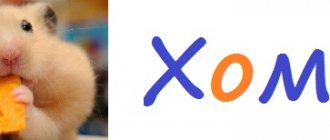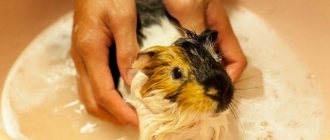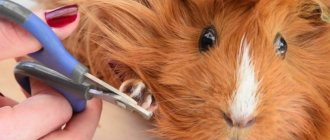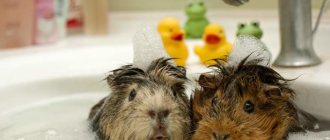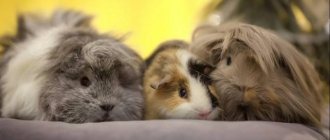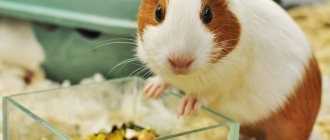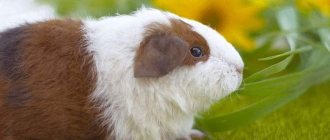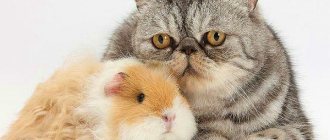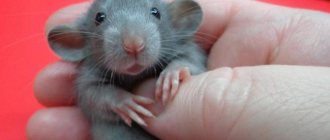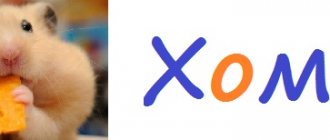- home
- Guinea pig
02/11/2019 Taming a guinea pig is much easier than it seems from the outside. Rodents are easy to train and willingly make contact with a person who treats them well. Each animal has its own character and habits that need to be studied and respected. This will help mutual understanding between the pet and the owner.
Adaptation to a new place
Until the animal feels completely safe, all attempts to tame a guinea pig will be in vain. Therefore, in such an important matter, you need to be patient, provide your pet with comfortable and calm conditions, and wait until he gets used to the new living conditions.
First of all, some conditions must be met:
- You cannot make noise near the cage;
- the drinking bowl and feeder should always be full;
- you need to arrange a shelter: a heap of hay behind which the animal will hide;
- the new resident must be isolated from other pets;
- people do not need to pet or forcibly hold the animal in their arms.
At first, the animal will naturally try to avoid contact with people. In the presence of strangers, the pet may even refuse food.
To facilitate the adaptation process, you can cover the cage or enclosure with a thin cloth.
Even if the pet does not show its anxiety, the owner must be as delicate and careful as possible.
The animal should not be disturbed for no reason, it should not be picked up, and there should be no sudden movements when cleaning the enclosure. In the first days of living in a new place, it is not recommended to let the animal walk around the apartment, because it may not find its way back. And the process of catching will lead to stress for the pet.
Features of behavior
Character
They are calm and friendly, love to play and run around the apartment.
Animals often lick their owner’s hands. This is how they express gratitude for your attention and love.
A guinea pig is a social animal that craves communication, affection and love. If you decide to have one, then keep in mind that you can’t just leave them alone, for them it’s a lot of stress, boredom and, as a result, a serious shortening of life
It is better to pay enough attention to them or bring a second relative into the house
When stressed, they can become aggressive and bite hard. Most often this happens when the animal is scared or unhappy (if you tear it away from food, for example). Stress is especially pronounced during a move; at this time it is better to leave the pet alone and give it time to adapt. Also, the animal can show aggression before bedtime.
Behavior
Guinea pigs have excellent hearing, so in nature they use verbal signals that allow them to communicate with each other and transmit information
- A shrill squeak. If you hear it from your pet, know that he demands to be fed immediately.
- Clicking - with this signal the guinea pig wants to say that you are crossing the boundaries of its personal space and demands that you respect its tendency to be alone.
- “Cooing” is great, he wants to thank you for finally deigning to feed him or stroke his fur.
- A quiet whistle - the animal is clearly scared and wants a hug.
- Grunting - this sound is incomparable to anything. You will hear it when your guinea pig sees another pet.
To determine their mood, it is enough to observe their behavior. A sign of a good mood is that the guinea pig is active. She runs, jumps, buries herself in sawdust. This suggests that she is satisfied with everything. If the animal sits motionless for several hours, then this is a call. This means he doesn’t like something and may have health problems.
Taming methods
Over time and with the proper approach, the pet gets used to the person and is less afraid. After complete adaptation to the new place of residence, you can continue to tame the animal. In this case, the time spent can be very different, everything will depend on the nature of the pet.
Getting used to the owner
You can tame a guinea pig to its owner in stages:
- The owner should constantly talk to the pet in a gentle and calm voice, while simultaneously offering the animal treats.
- As soon as the animal begins to calmly react to the presence of a person, they move on to taming it by hand. To do this, open the cage door and offer the pet a treat, at the same time allowing you to sniff your hands.
- When the animal begins to calmly accept treats from human hands, you can try to slowly stroke it. However, to prevent your pet from perceiving your actions as aggression, you should not touch his rump.
- A little later, you can pet the animal without giving it a treat. It will gradually become clear whether the animal likes such actions or not.
- After mastering stroking, you can begin to pick up your guinea pig.
- In order for the adaptation to the owner to go smoothly, it is recommended to avoid situations that are unpleasant for the animal. Try to avoid actions that cause any discomfort to your pet.
- The cavey should be handled correctly, held and stroked in such a way that it feels good.
Getting to know the toilet
Many people are convinced that it is impossible to litter train a guinea pig. However, this opinion is wrong. Rodents have developed intelligence to understand where to defecate.
There are many different types of trays for pigs, but they are usually containers with a hole so that the animal can freely climb inside.
You can toilet train your guinea pig using granular litter.
It compares favorably with other materials in that it perfectly absorbs moisture. This means that such a filler will have to be changed quite rarely, thereby disturbing the pig less.
One of the most important points is choosing the optimal location for the toilet. You need to take a close look at the animal and understand where it goes all the time. It is recommended to place the toilet in this place.
Place some used litter in the tray. When the animal wakes up, you need to put it in front of the tray. By smell, he will quickly determine what the structure is intended for. If the animal refuses to go to the designated place, then you can install several toilets at once so that the animal chooses the one it likes. In this matter, it is very important to be patient, because gradually the pet will understand what’s what.
Team training
After taming, they begin to train guinea pigs
It is important to remember that you should not shout at your pet or use force against it.
You should not try to master all the tricks in one training session. It is better to start with simple commands, and after successfully mastering them, move on to more complex options.
The tasty reward should be removed gradually and only after the command has been fully mastered.
Stand
The simplest command for any animal. To teach this command to a guinea pig, you need to place the animal on a flat, hard surface. A treat is held over the pet's head. The animal reaches for the treat, at which time the owner calmly says “stop.” The animal can reach the treat by standing on its hind legs. When this happens, the animal is praised and treated. The command must be repeated several times and the pet must be treated. These actions need to be repeated until the animal understands what is required of it. After mastering the command, it is repeated periodically so that the pet does not forget.
To me
This team will need about two weeks to train. To begin with, the rodent is placed on a flat surface a meter from the owner. Then the owner shows the pig a treat and calls him by name in a calm voice. As soon as the animal approaches, you need to pet it and treat it with a treat. It is better to do classes every day. After mastering the command, the distance between the student and the teacher is increased.
U-turn
To execute this command, you need to bring the treat over your pet's head. When the pig becomes interested in the treat, you need to slowly begin to describe a circle above the animal’s head. It is better to move your hand clockwise, while repeating the command “circle” or “turn around”. You should not immediately make a circle if the animal quickly loses interest in the treat. You can first make turns of 45 degrees, then 90 and until the turn is complete. You need to train every day so that the animal does not forget the learned elements.
Kiss
It doesn't take much effort or training to execute this command. All you need to do is hold a piece of the animal’s favorite treat with your lips. Then you need to bring the pig to the owner's head. As soon as the pet smells the tasty treat, it will reach out to its owner’s lips and take a piece.
Give me your paw
This command is more difficult to execute than the previous ones. To do this, you need to put the pig on the sofa. The owner himself is located in front of the rodent on the floor. He extends his left hand, palm up, towards the animal, and with his right hand he lures the animal with a treat. When the animal begins to move towards the person, the owner gives the command “give me your paw.” And as soon as the student’s paw is in his hand, the animal is praised and treated to something tasty.
It is important to be careful so that the animal does not fall on the floor
Achieving results in executing this command requires regular training.
Roll the ball
This command is also based on the guinea pig's natural desire to eat. To execute the command you need a ping pong ball or other small light ball, a strip of carrot or celery. Place the treat under the ball and wait for the pet to become interested in it. And then you can give the command “Push.” To get the treat, the pig will have to push the ball with its muzzle. This team needs to be trained regularly to achieve results. After a few sessions, the bait is removed from under the ball.
Jump through the ring
This command will require a ring and a treat. You can make the ring yourself from wire or use a tennis racket after removing the fishing line.
First, the ring is placed edge-on on the floor. A pig is placed on one side of the ring, and a treat on the other. Having noticed the treat, the pet will go to it through the ring. At the same time, the owner gives the command “ring”. If your pet doesn’t see the treat, you need to move it closer.
As soon as the pig gets through the ring, he should be praised and allowed to treat himself. Over time, the ring is raised. The final lifting height of the ring is considered to be a distance of 3 cm.
Trained guinea pigs are not exotic, but a completely normal phenomenon. Each owner can teach the animal to follow commands in order to develop it and entertain it. And the owner will also have a pleasant time with his pet.
What to do if your pig is afraid
Undoubtedly, it is easier to make friends with a young animal than with an adult. Adult pigs take a long time to get used to people.
Animals bought in a store are usually not sociable, because buyers do not always demonstrate friendliness and tact in treating them.
To avoid frightening the animal, try offering him treats only from your hands. It is also very useful to have conversations with your pet, sitting him on your lap and stroking him.
It’s good to place the cage for a while closer to the owner’s favorite place. Constantly being in the company of the owner, the pet will understand that there is no threat from this side.
However, cavey does not like to be held, not only because of fear. The reason may be independence and love of freedom. Keep in mind that not every pet wants to sit on your lap. If he bites his owner's clothes or skin with his teeth, it means he is uncomfortable.
It happens that a pet does not go to hand for a long time due to the fact that there is a house in the cage. Behind its solid walls the pig feels safe.
People who talk loudly and gesticulate intensely can frighten a guinea pig. Animals feel threatened by this behavior.
A hunched posture may not be due to fear, but to poor health. If this behavior is noticed in your pet, it is recommended to immediately consult a veterinarian.
Training methods
Most likely, your pet has already chosen a permanent place for her needs. In this case, all that remains is to buy a tray for rats or make one from an unnecessary food container and secure it so that the animal does not move it during use.
If you choose a special litter that is unfamiliar to the rat by smell, you need to put some of its droppings and already used litter in the new litter box. Reward your pet every time he goes to the litter box with a treat.
When there are several rats living in a cage, each one usually has its own latrine. The solution to the problem (if the size of the cage allows) is several containers placed where traces of urine and excrement are most often visible.
https://youtube.com/watch?v=iL4K7zXmGeM
Some individuals relieve themselves in different parts of the home. In this case, you will have to stock up on endurance and perseverance in order to accustom him to the toilet in one place. Here you need to proceed in this way:
- Remove the filler from the cage, rinse the cage thoroughly and disinfect it to remove the odor.
- Place a clean cloth, waffle towel or diaper on the bottom. If the animal begins to chew on such bedding, you will have to replace it with a more traditional one, but different from the litter for the tray.
- Fill the container by adding the already used litter and rat droppings.
- put the rat in the tray, and when the pet uses the toilet, give a treat.
You will have to watch the animal for several days. Regularly put him in the tray, and then be sure to encourage him.
Sometimes it can be difficult to accustom a rat to a litter tray, especially for adult rats. You cannot shout or punish the animal. Your shouting and wrong actions will only scare him.
It is up to you to help your pet understand the difference between the toilet area and the living area of the cage. To do this, immediately remove the wet piece of litter and excrement. At first, you will have to do this several times a day. When replacing the litter, do not forget to leave some of it in the container, and also add droppings there.
Favorite caresses for a guinea pig
When petting your pet, pay attention to its reaction. Many pigs simply love to have the bridge of their nose stroked, their neck and the area behind the ears scratched. But if an animal pushes the hand stroking it with its head, it means it doesn’t like something.
Guinea pigs also enjoy being petted on their barrels, just like cats. However, such caresses
The animal usually only allows it to a person whom it trusts completely and completely. Therefore, at the first stage of dating, such caresses are unacceptable.
Like dogs, pigs love affection, especially when they are petted and scratched near the ears. This area is highly sensitive, so don't overdo it. Monitor your pet's reaction until he puts your hand under your arm and you can safely continue.
Adviсe
- If you have multiple guinea pigs, only handle them one at a time.[19]
- Be sure to use both hands when lifting your guinea pig.[20]
- Always make sure you have a secure grip on your guinea pig before lifting him more than 2.5-5cm off the floor. If your guinea pig is running around the floor of the room, it will be more convenient for you to first squat or bend over it and only then pick it up and stand up.
- Make sure your pig always has hay and food.
- Guinea pigs are fragile creatures and usually don't like having sensitive parts of their bodies touched. Before petting your pig, see how it reacts to being stroked in different places.
How to hold a pig correctly
It is very important to learn how to properly hold an animal in your arms. Although this animal is small in size, it is relatively heavy. Therefore, if you hold him up, it may hurt him. Therefore, he must be able to rely on the owner.
So, let's learn how to hold a guinea pig in your arms correctly:
- one palm is placed behind the front paws, clasping the chest;
- with the other hand, carefully support the back;
- you need to hold the animal tightly, but not too squeezing.
The Cavie's build is not at all conducive to striking. A fall, even from the smallest height, can cause severe bruising, injury and lead to the death of your pet.
Care of offspring
In addition, if caring for sea piglets rests entirely with you, you will need to gently massage their tummies with a cotton swab previously soaked in vegetable oil. Normally, this is done by the female in order to stimulate bowel movements in babies and prevent stagnation in the intestines of newborns. Without such massagers, little guinea pigs may experience pain and suffer from constipation.
The lactation period for guinea pigs lasts about three weeks, which is how long they will feed their offspring. After this, the piglets are already completely independent and can do without the help of their parent.
Important nuances
Before taming a guinea pig, carefully study its behavior and mental characteristics. Undoubtedly, animals love:
- Peace and quiet. In a noisy environment, animals become restless, irritable and even aggressive. Working with an animal in such conditions is completely useless.
- The presence of a large amount of hay in the cage. Guinea pigs just love to burrow into the grass.
- Juicy vegetables and fruits, as well as a variety of greens, contain useful microelements that strengthen the immune system.
Some breeds of pigs are very picky about the temperature conditions in the room, they get cold and often catch colds. And when the pet feels any discomfort, taming classes are out of the question. You should never start playing with your guinea pig until it is accustomed to its new environment.
But when the animal’s adaptation is successful, when it is possible to tame the pet, the owner will find a faithful friend who will delight the owner and family members with games and tricks for many years.
Training rules
There are no special secrets in pig training - after all, its main principles are:
- owner's patience;
- constancy;
- subsequence;
- reward items - treats.
Did you know? All rodents are very clean creatures. They look after not only themselves, but also their relatives.
So, the first rule is to observe your pet’s normal behavior. Just sit nearby and see what your guinea pig tends to do.
The second rule requires the presence of a signal source, treats and silence. When the animal does what you want, you should blow the whistle (you can choose any suitable signaling device) and give the animal a treat. By doing this, a person gradually reinforces the reflex behavior of a furry creature.
Find out also how much guinea pigs cost.
What food options are suitable as incentives? They become all the foods that your pig loves most. Does she chew carrots with pleasure? Prefers to chew on something else? Together with her, choose the best treats. Let her be happy to receive them.
Video: Guinea pig training
Buying a tray
Mini pigs will need their own litter box; the pig will never share it with other pets.
The pet store does not sell special trays for pigs. We'll have to look for an alternative.
A spacious plastic box with low sides will do; your pig will definitely like it. It is better to take a large box right away - for growth.
Some people use children's plastic bathtubs or swimming pools as toilets. You need to cut the entrance and the toilet is ready! Some models already include an input.
You can use a bath as a tray. Lay down an anti-slip rubber mat. This will protect the pig from sprains and injuries.
Wash the tray or tub daily. To eliminate unpleasant odors, add baking soda and talc to the bottom.
To train your piglet, take some toilet paper and feces and place it in a new litter box. This way the pig will navigate by smell. Leave the remaining droppings in the tray so that the pig will be guided by the smell where to go to relieve itself.
After completing the procedure, you should not treat your pet with a treat for encouragement. This may confuse him. It is necessary for the pig to understand that it is his direct responsibility to relieve himself in the litter tray!
During the learning process, the pig may make a mistake; you should not punish him or scold him. This is unlikely to help, but it will certainly scare the pet.
Cell options
Owners of pet rodents are offered many options for homes. Let's try to study their strengths and weaknesses and determine whether they are all really suitable for pigs.
Aquarium and terrarium
Aquariums for guinea pigs have only two advantages - they are easy to clean and prevent debris from falling out of the cage. Unfortunately, in other respects glass vessels show their absolute unsuitability:
- lack of ventilation;
- accumulation of ammonia vapors and inhalation by animals;
- complete isolation of rodents from the outside world: pigs are not able to perceive anything through glass.
Inexperienced owners also consider guinea pig terrariums as housing, but these containers are not much different from aquariums. The conditions inside them are suitable only for flightless animals such as amphibians and reptiles, as well as insects. Rodents cannot live in terrariums.
Dune
Dune is a plastic container with a hole at the top. It has the same disadvantage as a glass cage - a complete lack of fresh air.
The reason for such a large number of plastic houses on the product market is low cost. This option can only be considered as a temporary habitat for the pig or a carrier.
For chinchillas, degus or birds
Cages for rats, chinchillas or birds should absolutely not be used as houses for guinea pigs, as they are tall and narrow:
- there will not be enough space for the pig to move around on the floor;
- the animal may be injured when trying to climb to the upper levels: the safe height to which a rodent can climb is only 10–15 cm.
Shelving
The trend to use shelving for keeping pets came from the West and is successfully taking root in Russia. The rack is a large cage for a guinea pig, it looks like a fence and is made of wood. Glass or metal mesh is also used to make it.
What are the benefits of racks:
- environmentally friendly and durable materials are used for creation;
- spaciousness and the ability to accommodate several rodents.
The shelving house, unfortunately, is quite heavy and bulky, so it takes up a lot of space in the apartment.
Lattice
Cages with bars, which are usually intended for hamsters, are characterized by the following negative features:
- The size of the guinea pig cage should correspond to standard parameters. And in homes for hamsters there is not enough space - the pet will begin to get nervous and behave inappropriately, and may get sick.
- Often the cage bars are covered with enamel to create a more presentable appearance. Pigs, accustomed to chewing everything, can swallow it and get poisoned.
The positive aspects of such structures:
- ventilation;
- strength;
- wide choose;
- Convenience of attaching accessories (drinkers, hammocks) to the bars.
Theoretically, if you solve the issue of dimensions and make a large cage, then lattice houses have a right to exist.
Aviaries
Making enclosures for guinea pigs with your own hands is not at all difficult, and they also have many advantages:
- space;
- being in the fresh air;
- beneficial physical activity.
However, not all owners have the opportunity to organize summer pens: the structure requires a courtyard and a safe area where it can be placed.
